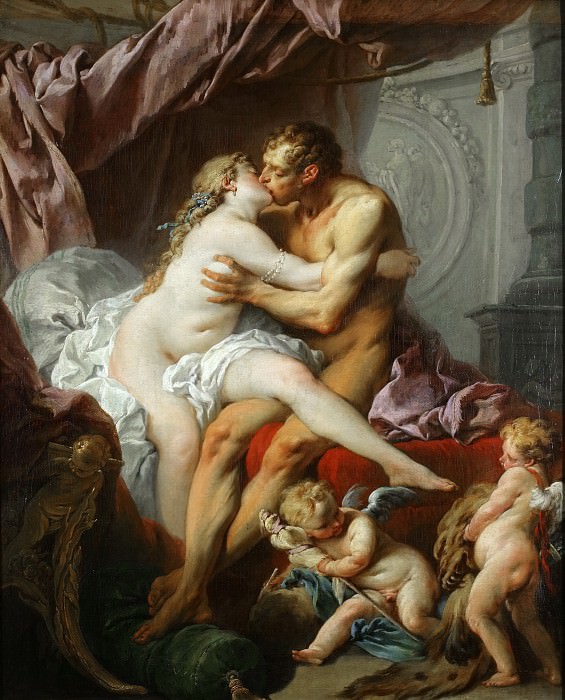Hercules and Omphale Francois Boucher (1703-1770)
Francois Boucher – Hercules and Omphale
Edit attribution
Download full size: 3130×3878 px (2,9 Mb)
Painter: Francois Boucher
Location: Pushkin State Museum, Moscow (ГМИИ им. Пушкина).
Hercules and Omphale belongs to the brush of the French painter François Boucher, a prominent representative of the Rococo period and one of the favorite artists of King Louis XV. Painted in 1735, it is considered one of his earliest works. It is in the Pushkin Museum of Fine Arts in Moscow. The basis for the painting was the myth about the son of Zeus and the earthly woman - Hercules. Trying to perform one of the 12 feats assigned to him, the hero finds himself in slavery to the queen of Lydia - Omphale.
Description of the painting "Hercules and Omphale" by François Boucher
Hercules and Omphale belongs to the brush of the French painter François Boucher, a prominent representative of the Rococo period and one of the favorite artists of King Louis XV. Painted in 1735, it is considered one of his earliest works. It is in the Pushkin Museum of Fine Arts in Moscow.
The basis for the painting was the myth about the son of Zeus and the earthly woman - Hercules. Trying to perform one of the 12 feats assigned to him, the hero finds himself in slavery to the queen of Lydia - Omphale. Such a terrible punishment is the punishment for killing Iphithe, son of Eurythus. Hermes, messenger of the gods, puts Hercules under the protection of Omphale for exactly 3 years.
The charms of the beautiful queen do not leave Hercules indifferent. The young hero gives her his heart, losing his striving for exploits and his inherent bellicosity. The man decides to stay at home, which for him is the kingdom of Omphale and so he puts on female clothes. Omphale withdraws him from hard work, forcing him to sit at the spinning wheel or help the slave girls. In the love union children are born, and later they become the first kings of Lydia.
For many centuries, Omphale was identified with the goddess Astarte or Aphrodite-Urania, combining the femininity of the weaker sex with the features of a true warrior.
Using this particular subject line for the painting, Boucher skillfully conveyed the erotic and sensual moments absent from the mythological retelling, but clearly not devoid of the right to exist. The central place in the painting is given to the main characters, Hercules and Omphale, seated in luxurious chambers. The bodies of the man and the woman are naked to the waist. On the right side in the corner you can see two cupids, which are pushing the lovers towards each other.
Bright colors are used to depict the passion that is boiling in the hearts of young people. The characters are well illuminated, which allows you to see the smallest details of the naked bodies, perfectly painted by the artist.
Кому понравилось
Пожалуйста, подождите
На эту операцию может потребоваться несколько секунд.
Информация появится в новом окне,
если открытие новых окон не запрещено в настройках вашего браузера.
You need to login
Для работы с коллекциями – пожалуйста, войдите в аккаунт (open in new window).


















COMMENTS: 1 Ответы
В прошлый раз Омфала была в связи с Амуром, вот и детки их внизу картины
You cannot comment Why?
The setting appears to be a richly decorated interior, with plush drapery in shades of purple and red framing the couple. The bed on which they sit is adorned with red cushions, suggesting luxury and comfort.
Adding to the scene are two cherubic figures, or putti, at the bottom. One, positioned in the foreground, is curled up as if asleep or resting, holding a spindle and distaff which are typical symbols of feminine domesticity and spinning. The other putto stands to the right, appearing to hold or examine a lionskin, a clear attribute of Hercules and his trials.
The subtext of this painting lies in the reversal of traditional gender roles and power dynamics. Hercules, renowned for his strength and feats of heroism, is depicted in a moment of submission to Omphales allure. The presence of the spinning implements in the hands of a putto, and the lionskin being handled by another, subtly suggests Hercules has temporarily laid aside his masculine duties and taken up feminine tasks as part of his penance to Omphale. This scene highlights themes of love, sensuality, and the power of attraction, as well as the complexities of gender roles even within a mythological context. The painting captures a moment where the lines between hero and lover, strength and softness, are blurred, inviting contemplation on the nature of power and desire.